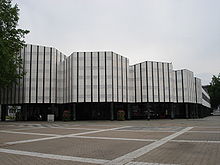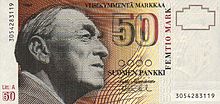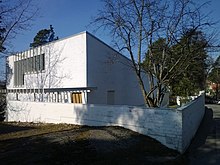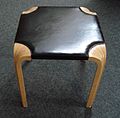Alvar Aalto
Hugo Alvar Henrik Aalto [ ˈhuːgɔ ˈɑlvɑr ˈhɛnrik ˈɑːltɔ ] (born February 3, 1898 in Kuortane , Grand Duchy of Finland , Russian Empire ; † May 11, 1976 in Helsinki , Finland) was a Finnish architect , urban planner and furniture designer . He became known for his special concepts in the field of organic building and is regarded in many Nordic countries as the "father of modernism " and as a pioneer of Finnish architecture .
Aalto mainly used wood for his furniture designs; in contrast to other designers of his time, he rejected artificial materials such as tubular steel. He also designed textiles and glassware , and the Aalto vase is a popular designer piece . The Aalto University in Helsinki bears his name since of 2010.
Life


Aalto was the grandson of a forester and the son of a surveyor . He was the firstborn of four siblings. Finnish and Swedish were spoken in his liberal family. The family moved to Jyväskylä in 1903 . In addition to attending primary school, he received painting and piano lessons. Aalto graduated from high school in his hometown in 1916, which was founded in 1858 as the first Finnish-language high school ever. There he learned German, among other things. The following summer, Aalto completed an internship with the architect Toivo Salervo , who advised him not to study architecture and to become a newspaper editor.
From 1916 to 1921 he studied architecture at the Polytechnic in Helsinki . His teachers were Usko Nyström , lecturer in architecture in antiquity and the Middle Ages, and Armas Lindgren , lecturer in modern architecture as well as building and construction theory. After completing his studies, he traveled to Riga , followed by military service in the reserve officers' school in Hamina . His father was his first client, who had the Mammula house rebuilt according to his designs . In 1923, Aalto and assistants opened an architecture office in the basement of a hotel in Jyväskylä after his plan to work as an architect in Helsinki failed. He published under the pseudonym Remus for the next four years in the daily newspaper Sisä-Suomi . In 1924 he married his assistant Aino Marsio . The bride and groom spent their honeymoon in Italy. In August of the following year a daughter named Hanni was born. The two architects lived in a single-family house designed by Wivi Lönn , and in 1926 they had a summer house built in Alajärvi . The Villa Flora was designed by Aino. In 1926 he visited Denmark and Sweden. In the former, he was impressed by the cozy, middle-class apartments; in Stockholm he made the acquaintance of Sven Markelius and Gunnar Asplund , with whom he was to become a lifelong friend.
In 1927 he moved the office to Turku . In 1928 the son Hamilkar was born. In the same year Aino and Alvar visited Sweden, Denmark, France and Holland. They made the acquaintance of Le Corbusier , Johannes Duiker , Sigfried Giedion , Fernand Léger and László Moholy-Nagy . Participation in the Congrès International d'Architecture Moderne ( CIAM ) expanded the circle to include Walter Gropius and Karl Moser . He was also friends with Agda and Erik Bryggman , with whom he devised projects.
The years 1927 to 1929 were decisive for Aalto's career. He received commissions for three important buildings that established him as the most progressive architect in Finland and earned him worldwide recognition. The first two are the editorial building of the Turun Sanomat newspaper in Turku and the city library in Viipuri (now in Russia). 1929 won Aalto competition for the construction of the sanatorium of Paimio with which he laid the foundation for his later advanced organic design and development including the well-known curved wicker chairs "Paimio". In 1933 the studio was moved to Helsinki. On October 15th, the Aalto couple founded ARTEK , a furniture manufacturing company , with Maire Gullichsen and Nils-Gustav Hahl .
From 1940 Aalto was Professor of Architecture at the Massachusetts Institute of Technology in Cambridge . In total, Aalto participated in around 200 projects, with around half of his designs being implemented. In 1959 he received first prize for the design of the opera in Essen. However, this opera was only built 12 years after his death under the architect Harald Deilmann and Aalto's second wife Elissa.
Aino Marsio died in 1949. In 1952 Aalto married Elissa Mäkiniemi . His wives signed for all of the designs. Alvar Aalto died on May 11, 1976 in Helsinki and was buried in the Hietaniemi cemetery.
Create
During the four-year existence of the first Alvar Aalto architecture office for architecture and monumental art in Jyväskylä, Aalto produced 36 designs, 14 were implemented. The most important buildings are the workers' house in Jyväskylä and the church in Muurame .
Aalto was influenced by the Deutscher Werkbund and the Bauhaus . It had its roots in the Nordic classicism of the 1920s, but it developed into a pioneer of modernism.
In the sense of organic architecture, he aimed for a close connection between buildings and landscape: “The objects surrounding people are hardly fetishes or allegories that have a mystical, eternal value. Rather, they are cells and tissues, as alive as these, the building blocks that make up human life. They cannot be treated differently from other units of biology, otherwise they run the risk of no longer fitting into the system, they become inhuman. "
Buildings and competition entries






1923:
- Villa Manner, Töysä
1924:
1926:
- Protection corps building, Jyväskylä
- Church, Muurame
1927
- Agricultural Cooperative Building, Turku
- Standard apartment block, Turku
- City Library, Viipuri (then Finland)
1928:
- Turun Sanomat newspaper office , Turku
- Tuberculosis Sanatorium , Paimio
1929:
- Turun Sanomat Newspaper Exhibition Building , Turku
1932:
- Villa Tammekann, Tartu , Estonia
1935:
- House and studio on Riihitie, Helsinki
1936:
- Finnish pavilion, world exhibition in Paris
- Cellulose Factory and Housing Development , Sunila , Kotka
- Interior of the Savoy restaurant, Helsinki
1937:
1938:
- Villa Mairea, Noormarkku
- Finnish Pavilion, New York World's Fair
- Elementary school, Inkeroinen
1947:
- MIT Senior Dormitory - Baker House, Cambridge, Massachusetts , USA
1949:
- Town hall, Säynätsalo
- Technical University, Otaniemi , Espoo
1950:
- Competition entry for the Malm Abdication Chapel, Helsinki
1951:
- “Rautatalo” commercial building, Helsinki
- Lakeuden Risti Church, Seinäjoki
- Pedagogical University, Jyväskylä
1952:
- Experimental house, Muuratsalo
- “House of Culture”, Helsinki
- People's Pension Office, Helsinki
1953:
- Competition entry for Vogelweidplatz, sports and concert hall, Vienna , Austria
1954:
- Atelier of the architect, Munkkiniemi , Helsinki
1955:
- Apartment building in the Hansaviertel for Interbau , Berlin , Germany
- Church of Three Crosses ( Kolme Ristiä in Finnish ), Vuoksenniska , Imatra
1956:
- Maison Carré, Bazoches-sur-Guyonne (near Paris), France
1958:
- Competition entry for a town hall, Kiruna , Sweden
- City center, Seinäjoki
- Aalto high-rise , Bremen - Neue Vahr , Germany
- Alvar-Aalto-Kulturhaus , Wolfsburg- Stadtmitte , Germany
- Art Museum, Aalborg , Denmark
1959:
- Aalto-Theater (opera house) in Essen (only carried out posthumously in 1988 under the direction of Harald Deilmann )
- Headquarters Enso-Gutzeit, Helsinki
- Holy Spirit Church and Community Center , Wolfsburg- Klieversberg , Germany
- Flame Monument Memorial to the Winter War Battles, Suomussalmi
- City center planning (not implemented), Helsinki
1960:
- Library, Seinäjoki
1961:
- Library, Rovaniemi
- Academic Bookshop, Helsinki
- City center, Rovaniemi
1962:
- Finlandia Hall , Helsinki
1964:
- Administrative and cultural center, Jyväskylä
1965:
- Nordic House, Reykjavík , Iceland
- Mount Angel Benedictine College Library , Oregon , USA
1966:
- Cultural center (not realized), Siena , Italy
- Santa Maria Assunta (Riola) Church and Community Center in Vergato , Italy
1967:
- Villa Kokkonen, Järvenpää
1968:
- Stephanuskirche , Wolfsburg- Detmerode , Germany
- Residential high-rise Schönbühl, Lucerne, Switzerland
1969:
1971:
- Alvar Aalto Museum, Jyväskylä
Furniture and utility glass
- Aalto vase
- Paimio armchair
- Armchair "Tank" (= tank)
- Model No. 31, rocking chair with armrests, 1930–1931
- Stool no. 60, 1933
- Model No. 98, tea trolley, 1935-1936
Tank chair with reindeer skin
Honors and memberships
Aalto was a member of the Congrès International d'Architecture Moderne from 1928 to 1956 . From 1963 to 1969 he was President of the Finnish Academy . Since June 4, 1969, Aalto was a foreign member of the Prussian order Pour le Mérite for science and the arts . He was also a member of the American Academy of Arts and Sciences (since 1957) and an honorary member of the American Academy of Arts and Letters (since 1968).
Aalto was awarded the Royal Gold Medal of the Royal Institute of British Architects (1957) and the Gold Medal of the American Institute of Architects (1963). In 1965 he received an honorary doctorate from the Vienna University of Technology . In 1974 he was awarded the Austrian Decoration for Science and Art .
portrait
The Finnish 50 Mark banknote from 1986 shows a portrait of Alvar Aalto.
See also
literature
in alphabetical order by authors / editors
- Karl Fleig (Ed.): Alvar Aalto. Complete works. Zurich 1970–1978, three volumes, 7th edition, Basel 1999.
- Teppo Jokinen, Bruno Maurer (ed.): "The Magus of the North". Alvar Aalto and Switzerland. gta Verlag, Zurich 1998, ISBN 978-3-85676-086-1 .
- Peter Blundell Jones, Jan Woudstra: Some Modernist houses and their gardens, part 6: Alvar and Aino Aalto's House at Munkkiniemi . In: Die Gartenkunst 26 (1/2014), pp. 107–123.
- Mateo Kries, Jochen Eisenbrand (eds.): Alvar Aalto - Second Nature. Publication on the occasion of the exhibition "Alvar Aalto - Second Nature", Vitra Design Museum GmbH and authors, Weil am Rhein 2014, ISBN 9783931936877 (German edition), ISBN 9783931936938 (English edition).
- Louna Lahti: Alvar Aalto 1898–1976. Little People's Paradise. Taschen Verlag, Cologne 2004, ISBN 3-8228-3524-2 .
- Susanne Müller: Aalto and Wolfsburg. A Scandinavian contribution to German post-war architecture. VDG Verlag, Weimar 2008.
- Malcolm Quantrill: Alvar Aalto. A critical study. London 1983, ISBN 0-436-39400-6 .
- Göran Schildt : Luonnoksia Aalto, Alvar , Helsinki Otava, 1972
Exhibitions
- Alvar Aalto - Second Nature , Vitra Design Museum , Weil am Rhein. September 27, 2014 to May 31, 2015
Web links
- Literature by and about Alvar Aalto in the catalog of the German National Library
- Simona Martinoli: Aalto, Alvar. In: Historical Lexicon of Switzerland .
- Architectural firm Aalto, Alvar. In: architekturbibliothek.ch
- Aalto, Alvar. In: architekturbibliothek.ch
- Entries on Alvar Aalto in the online database architekturführer bremen of the Bremen Center for Building Culture (b.zb)
- Alvar Aalto biography at WHO'S WHO
- Video reconstruction of the not built church project in Zurich-Altstetten .
- http://kuenstlerdatenbank.ifa.de
- Alvar Aalto in Google Arts & Culture
- Sound recordings by Alvar Aalto
- Olivia Steiner: Schönbühl residential high-rise, Lucerne. In: architekturbibliothek.ch
Individual evidence
- ↑ Alvar Aalto , Architecture & Living .
- ↑ a b c H. F. Koeper: Alvar Aalto . In: Encyclopædia Britannica .
- ^ A b Paul Cattermole: Aalto, Alvar. In: Paul Cattermole, Simon Forty: Architects from Aalto to Zumthor. Prestel Verlag, Munich 2013; P. 10. ISBN 978-3-7913-4768-4 .
- ↑ Alvar Aalto in the speech »Rationalismus und Mensch«, 1935. Quoted from Louna Lahti: Alvar Aalto 1898–1976. Little People's Paradise. 2nd edition, Cologne 2009, p. 11.
- ↑ http://janmichl.com/eng.aalto.html
- ↑ Alvar Aalto's Savoy Vase Continues to Inspire Designers ( Memento from April 2, 2012 in the Internet Archive )
- ^ TU Wien: Honorary doctorates ( Memento from February 21, 2016 in the Internet Archive ). Retrieved March 26, 2015.
- ↑ World Paper Money, 14th edition 2008, p. 362, no. 114.
- ^ [1] Aalto 2014 exhibition on the Vitra Design Museum homepage
- ↑ The way to a humane modernity. Nature was Alvar Aalto's role model, human well-being his goal: The Vitra Design Museum pays tribute to the Finnish architect, whose work is more topical than ever. Andreas Herzog in Tages-Anzeiger on October 2, 2014, page 25
| personal data | |
|---|---|
| SURNAME | Aalto, Alvar |
| ALTERNATIVE NAMES | Aalto, Alvar Hugo Henrik (full name) |
| BRIEF DESCRIPTION | Finnish architect and industrial designer |
| DATE OF BIRTH | February 3, 1898 |
| PLACE OF BIRTH | Kuortane , Grand Duchy of Finland , Russian Empire |
| DATE OF DEATH | May 11, 1976 |
| Place of death | Helsinki , Finland |









